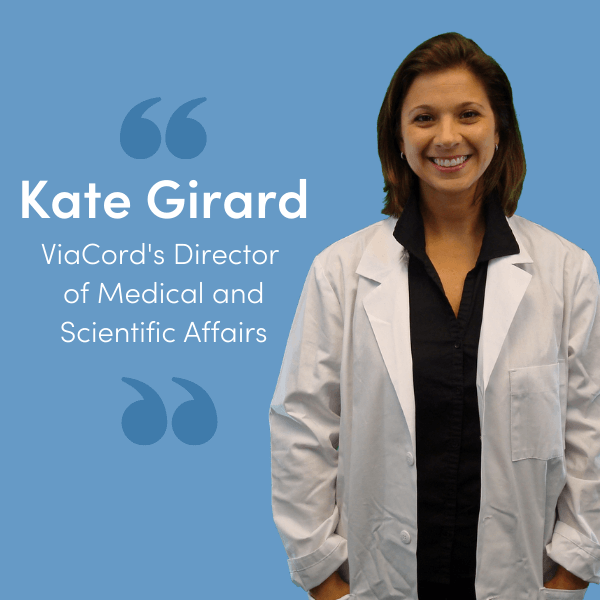UCLA researchers recently presented at the Conference on Retroviruses and Opportunistic Infections on the first HIV-1 (HIV) patient to achieve HIV remission using cord blood stem cells as part of a stem cell transplant to treat the patient’s cancer, acute myeloid leukemia (AML).
Perhaps you are already familiar with this story because it has been published by major news outlets such as The New York Times, The Wall Street Journal, CNN, People, in addition to ABC, NBC and CBS.1 TheScientist summarized the coverage very well here if you are interested.
Seeing cord blood stem cells used for this treatment is exciting for everyone at ViaCord. After all, the use of cord blood stem cells in stem cell transplants has proven to be lifesaving for our own ViaCord families. However, this case is truly unique and a bit complex, so we asked ViaCord's Director of Medical and Scientific Affairs, Kate Girard, to help us understand it a little better.

The easiest way I can try to explain this case is to overview some of the key points:
- The patient was a woman of mixed race who had both HIV and leukemia (ALL)
- The stem cell transplant was primarily used to treat her cancer…and HIV secondarily
- The stem cells used in the transplant came from 2 sources – peripheral blood and cord blood (both donated)
- The cord blood came from an unrelated donor and the adult stem cells from a relative of the patient
- The cord blood stems cells contained a known HIV-protective gene mutation
- This is the first-time cord blood stem cells were used as part of the treatment for HIV
- The patient has been “functionally cured” of HIV (in remission of AML for 4½ years and has had no HIV rebound in the 14 months since antiretroviral therapy was stopped) 2
Ok, let's dig in . . .
There’s so much to talk about with this new finding, but today I am going to focus on two key topics:
- Matching of a stem cell “donor” with a patient
- The HIV-protective mutation
Matching
One of the many advantages of using stem cells from cord blood in a transplant is that they can be used without being an exact match to the recipient's HLA (Human Leukocyte Antigen). Successful stem cell transplants are dependent upon matching. Your body's cells contain antigens on the surface of their cells that act as markers. These markers allow the body to recognize/distinguish your own cells and foreign cells. HLA typing is used to match these markers in the donor to the recipient. The better the match, the less likely it is a donor’s cells will attack a patient’s cells after transplant (also known as Graft vs. Host disease (GVHD).3
Cord blood stem cells are more ‘lenient’ when it comes to matching because they are young and immunologically naïve. The host is therefore less likely to recognize the stem cells as foreign because they have not had as much 'life experience' as adult stem cells. Cord blood's more relaxed matching criteria help make it possible to treat more patients, more family members, and a more diverse population.4
HIV-Protective Mutation
Most people think of gene mutations as causing disease, but some gene mutations can actually protect from serious conditions like diabetes, high cholesterol, and HIV.5 The patient in this case received cord blood containing the CCR5-delta 32/32 homozygous mutation. Researchers have found that this mutation, found to occur naturally in 1% of people descended from Northern Europeans, essentially prevents HIV from entering immune cells.6 Thousands of cord blood transplants have been done over the past thirty years, but this was the first time a cord blood unit was used to treat HIV. This is definitely an exciting discovery adding to the ever-expanding clinical potential of cord blood stem cells, but there is not enough evidence to speculate that cord blood will become an approved treatment for HIV in the future.
The Takeaway
There is no way we can imply that this represents a cure for HIV. . . or even a treatment method that will one-day have widespread application. For this one patient, the outcome has been incredible. And for the 30+ million people with HIV, this could provide additional hope. In terms of Cord Blood, it raises some valuable clinical insights and demonstrates the value, versatility and potential of this stem cell source. I think news like this reinforces the decision made by so many parents to save their children’s Cord Blood - not only for what it can do now, but also for what it may be able to do in the future. In addition, this makes me feel even more optimistic about the role cord blood may play in the development of future treatments and therapies.
I think Dr. Deeks in The New York Times: A Woman is Cured of HIV Using a Novel Treatment article summed-it-up beautifully when he said “umbilical stem cells are attractive . . . there’s something magical about these cells and something magical perhaps about the cord blood in general that provides an extra benefit.” In a future post, I’ll get into the potential role cord blood may play in the repair & use of gene mutations in treating conditions beyond HIV.

Thank you so much, Kate! We appreciate you taking the time to help break down this exciting news. We look forward to you joining us in future blogs.
Follow us on Facebook, Twitter, and Instagram to join the conversation and stay up-to-date on cord blood & tissue, genetics, pregnancy, and everything in between!
Disclaimer: Banking cord blood does not guarantee that treatment will work, and only a doctor can determine when it can be used. PerkinElmer or ViaCord does not endorse or make recommendations with respect to research, medication, or treatments. All information presented is for informational purposes only and is not intended as medical advice.
References
1. Media Coverage
The New York Times; https://www.nytimes.com/2022/02/15/health/hiv-cure-cord-blood.html
The Wall Street Journal; https://www.wsj.com/articles/woman-appears-cured-of-hiv-after-umbilical-cord-blood-transplant-11644945720
CNN; https://www.cnn.com/2022/02/15/health/hiv-third-person-remission/index.html
People; https://people.com/health/woman-becomes-third-person-to-be-cured-of-hiv-after-researchers-use-new-stem-cell-method/
ABC; https://abcnews.go.com/Health/breakthrough-treatment-makes-woman-3rd-person-cured-hiv/story?id=82907276 NBC; https://www.nbcnews.com/nbc-out/out-health-and-wellness/scientists-possibly-cured-hiv-woman-first-time-rcna16196
CBS; https://www.msn.com/en-us/money/other/patient-at-weill-cornell-medical-center-cured-of-hiv-infection/vi-AATTUVg
2. UCLA Health at CROI: Presenting the case of a woman with HIV-1 in remission following specialized stem cell transplantation for leukemia; February 15, 2022 https://www.uclahealth.org/news/ucla-health-croi-presenting-case-woman-with-hiv-1-remission
3. Cleveland Clinic; Graft vs Host Disease: An Overview in Bone Marrow Transplant https://my.clevelandclinic.org/health/diseases/10255-graft-vs-host-disease-an-overview-in-bone-marrow-transplant
4. Gupta, Ashish O, and John E Wagner. “Umbilical Cord Blood Transplants: Current Status and Evolving Therapies.” Frontiers in pediatrics vol. 8 570282. 2 Oct. 2020, doi:10.3389/fped.2020.570282 https://www.ncbi.nlm.nih.gov/pmc/articles/PMC7567024/
5. Williams, Sarah C P. “Genetic mutations you want.” Proceedings of the National Academy of Sciences of the United States of America vol. 113,10 (2016): 2554-7. doi:10.1073/pnas.1601663113 https://www.ncbi.nlm.nih.gov/pmc/articles/PMC4791022/
6. Paoli, Julia “HIV Resistant Mutation” 06 Oct. 2013, Nature https://www.nature.com/scitable/blog/viruses101/hiv_resistant_mutation/#:~:text=A%20genetic%20mutation%20known%20as,sit%20outside%20of%20the%20cell











